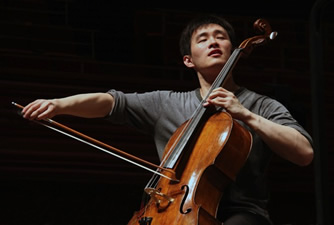Paul Conway and the Hillyer Community Chorus have firmly established their niche in the Triangle by offering up little known choral works by now-forgotten composers. Conway scours musty libraries and makes numerous contacts abroad to seek out works which often have been unperformed for a century or two. The public response to these offerings was dramatically indicated on Sunday afternoon, December 15th, 2002, in Raleigh’s Hillyer Memorial Christian Church, where the audience was filled literally to the rafters, as the overflow climbed to the upper level side seating.
This concert’s exhumation was German composer Conradin Kreutzer (1780-1849), His works were praised by Haydn and Beethoven, and he has some name recognition from his opera Das Nachtlager in Granada . Otherwise, none of his other operas (fifty in all), chamber music and choral works are remembered, many of them never having been published. Luckily, Conway was aware of the musicological work being done on the composer by a German professor, Alexander Sumski, through whom unpublished chorus parts and conductor’s scores were obtained, as well as valuable background on all three pieces performed in this concert.
Kreutzer’s style was quickly established with his Fantasia in B-Flat Major for bassoon and orchestra, a single movement set of variations lasting about ten minutes. After a sweetly lyrical introduction, the happy main theme ambled along, then morphed into versions which burbled, sang and cried. NC Symphony bassoonist John Pederson took mere seconds to confirm his highly developed talent, easily handling the long-winded lines, the extreme range leaps and the speedy staccatos. The subtlety he employed for dynamic changes was especially impressive. The audience’s genuine, heartfelt reaction to Pederson’s performance was one of the strongest heard at a Hillyer concert.
Conway led his players with an appropriate bounce, the high strings being the only disappointment. Their thin, smeared bowing unfortunately was to last throughout the rest of the concert, the one spoiler to an otherwise extremely satisfying afternoon.
A Te Deum was the first of two choral works, this one lasting a mere five minutes, employing only selected wording from the full, traditional Te Deum. The opening triumphal section had sharp rhythms and an upbeat thrust. The “Te Ergo” section featured a short, quiet passage from the quartet of soloists, followed by a sweetly reverent chorus, punctuated by a gently driving underlying beat and a soulfully pleading oboe (Mary Greiner). The final “Quemadmodum” had a glorious brightness, with the chorus line moving in large blocks abetted by resounding drum beats. The piece was quite effective for a short work, aided by Conway’s taunt control. The precision, dynamics and diction from the chorus was exemplary.
Written around 1822, this Te Deum harked back towards Mozart more than being grounded in the Romantic conventions of the time. That same impression held for the half-hour Messkircher Messe (named for his hometown), which dates to at least twenty years later. The music was confidently composed, with some lyrical sections matching its time period, but often the music held onto the formality of an earlier age and the almost relentlessly sweet and bright melodies often seemed at odds with the words of the Mass.
That said, the music was still infectious and the performers attacked it with gusto and commitment. Most gratifying was the strongest set of soloists to be heard at Hillyer in some time. Here Kreuzter gave most of the emphasis to the soprano and Mary Kathryn Walston proved well up to the demands. Several of the soprano lines call for coloratura display and others ask for long-lying high notes, both of which Walston easily encompassed. Despite some intonation problems and some less than firm notes, this was Walston’s best showing at Hillyer. She blended beautifully with alto Nancy Brenner, tenor Mel Williams and bass Richard Wilson, making one wish that these other members of such a superb quartet had been given more solo opportunities by the composer.
Many of the sections of this Mass seems hurried over, making one wish for more development. However, the one time Kreutzer attempted it offered mixed results. The opening and closing parts of the “Benedictus” featured extended passages for clarinet, almost a mini-concerto, Brent Smith giving wonderful character to the graceful runs. Otherwise, the long, repeating sections of the “Benedictus” did not have a lot of variety or invention, despite the several lovely duets for alto and tenor.
The chorus was the best prepared and rehearsed heard at Hillyer for years. The balance was particularly noteworthy, the blend gratifyingly smooth. The powerful climatic moments were quite thrilling.
Conway’s attention to detail, especially dynamic changes and precise cutoffs, showed the dedication and devotion he gives to all such discoveries. The audience’s enthusiasm should have been reward enough for all Conway’s admirable efforts, the extended applause and final standing ovation acknowledging one of his best concerts in memory.











